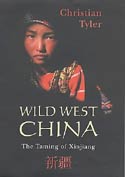
Wild West China: The Taming of Xinjiang
Closed to the world for half a century, like a black hole in the Asian landmass, the wilderness of Xinjiang in north-west China is returning to the light. The picture it presents is both fascinating and disturbing. Despite a savage landscape and climate, Xinjiang has a rich past: sand-buried cities, painted cave shrines, rare creatures and wonderfully preserved mummies of European appearance. Their descendants, the Uighurs, still farm the tranquil oases that ring the dreaded Taklamakan, the world's second largest sand desert, and the Kazakh and Kirghiz herdsmen still roam the mountains. The region's history, however, has been punctuated by violence, usually provoked by ambitious outsiders—nomad chieftains from the north, Muslim emirs from Central Asia, Russian generals or warlords from inner China The Chinese regard the far west as a barbarian land. . . . This portait of Xinjiang should be essential reading for travellers and for anyone interested in today's China and the fate of minority peoples.
Adrienne Mong writes in the Jan. 8, 2004, Far Eastern Economic Review,:
Wild West China is the first book to concentrate on the region's perspective, but many of the early historical stories have appeared elsewhere and in far more robust narratives. Tight restrictions on access and information mean there's little first-hand reporting, apart from the few private interviews Tyler conducts with activists and dissidents. Furthermore, Tyler—who expresses sympathy for the Uighurs while remaining even-handed—affects too dry a writing style. Nonetheless, Wild West China fills a gap in Central Asian history, particularly for general readers.
